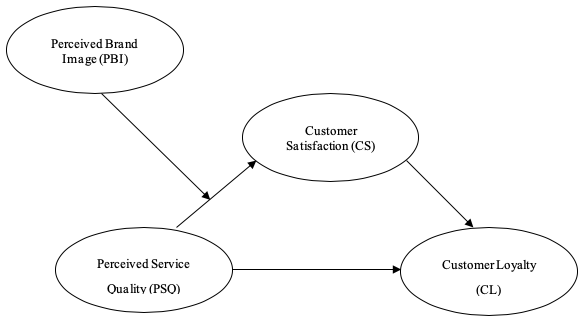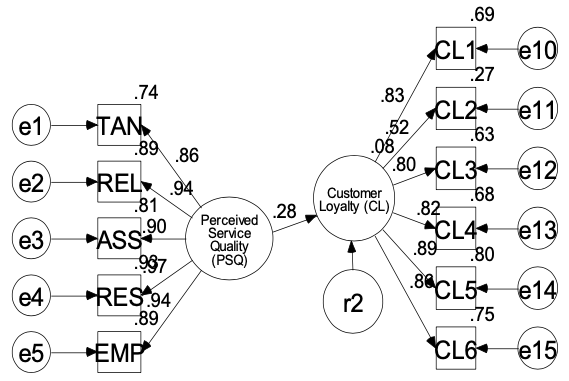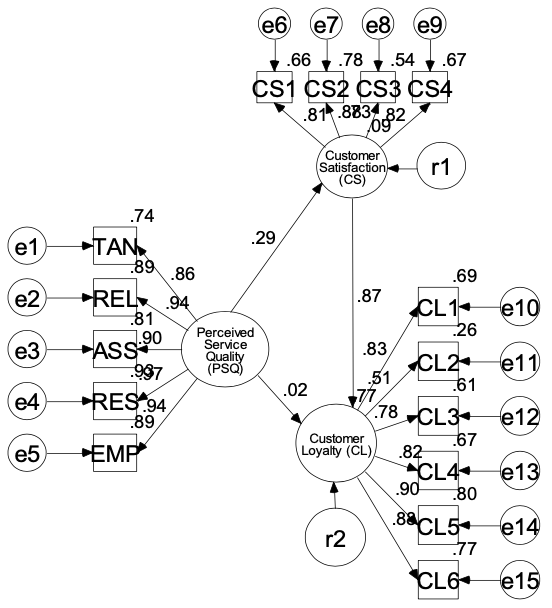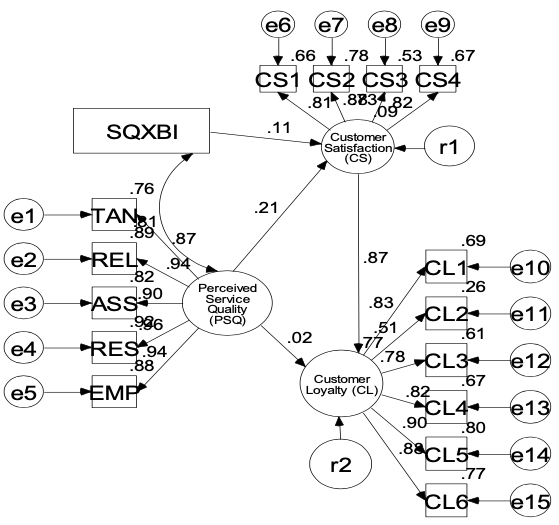

Vol. 40 (Number 35) Year 2019. Page 11
PATTNAIK, Sasmita 1; MISHRA, Uma Sankar 2 & MAHAPATRA, Jyotirmaya 3
Received: 28/06/2019 • Approved: 02/10/2019 • Published 14/10/2019
3. Research methods and design
ABSTRACT: As the service industry is growing in faster rate, proper service supply chain management has become a key issue before the producers in understanding customers’ perception. The present paper is focussed on the cause-effect links among service quality, perceived brand image, customer satisfaction and customer loyalty, particularly in Indian telecommunication sector. This study was customer survey based and data was collected through a well tested questionnaire. Survey result showed that, customer satisfaction plays mediating role and perceived brand image moderates the relationship between service quality and customer loyalty significantly. |
RESUMEN: A medida que la industria de servicios está creciendo a un ritmo más rápido, la gestión adecuada de la cadena de suministro se ha convertido en un tema clave para que los productores comprendan la percepción de los clientes. El presente documento se centra en los vínculos causa-efecto entre la calidad del servicio, la imagen percibida de la marca, la satisfacción del cliente y la lealtad del cliente, particularmente en el sector de telecomunicaciones de la India. Este estudio se basó en una encuesta de clientes y los datos se recopilaron a través de un cuestionario bien probado. El resultado de la encuesta mostró que, la satisfacción del cliente juega un papel mediador y la imagen percibida de la marca modera la relación entre la calidad del servicio y la lealtad del cliente de manera significativa. |
In today’s market scenario service sector is bigger contributor towards economic growth in any country. Service sector provide largest GDP to the developing countries. The world economy is shifted from manufacturing to services. In this competitive era every organization focused on increasing their customer value. Due to the growth of the market, customer demand also increased for lower price, faster delivery, improved quality products and many product options. For this, supply chain management plays an important role to minimize the cost for providing service to the customers.
Service supply chain in any service delivery system can be viewed as a chain or network of activities, which involves number of participants. Just like supply chain in manufacturing, in services also we can see that all the participants are related to each other. The structure of supply chain can vary from a simple serial supply chain to a broad network of supply chain entities. To achieve success, each player’s contribution is relevant in service supply chain system leading to gaining competitive advantage in any business.
With increase competition in Telecommunication sector, customers want better quality product in lower prices. Therefore the companies need to manage their supply chain effectively in order to provide the best service. To be a successful company, a satisfied customer is an important factor. In this globalized world, companies face difficulties to serve those customers spread across the globe properly and also retain them. Supply chain helps to build a stronger relation between the customer and the organization.
Service and product quality have a vital and encouraging impact on brand leadership which is a factor of brand equity (Hanyasha and Ghani). According to Keller (2003) global brands inspire the image of product quality status among their customers to increase their leadership position in their target markets. These strategies would enhance the value of the brand in the long run and provide competitive advantage. The leading brands are very powerful influencer, they attract customers through focusing on product quality and service quality dimensions (Beverland et al., 2007). For sustainable competitive advantage companies should give more emphasis on improving their product quality and service quality to fulfill the needs and satisfaction of their customer.
With intense competition between various telecom service providers, customer satisfaction is important for survival in the market. For creating wealth, Quality is generally regarded as a key factor which influences customer satisfaction. Hence, the telecommunication companies have to be strategically positioned to provide quality services to satisfy customers for their existence.
Telecom service providers need to constantly keep an eye on the dynamic market, their competition, and especially their customers. Customers of today are more demanding, expect higher levels of service, and crave new products. In this context, the present study aims at investigating the role of perceived brand image among customers of tele-services for achieving higher degree of loyalty through saitisfaction generated from quality service delivery.
For an organizational success quantity of customers is not important rather out of it how many of them are their regular purchasers are more important. This emphasizes the major role, customer loyalty plays in different firms. Commitment of customers in long run also brings profit for the companies. For developing, maintaining and protecting market share brand loyalty is vital. Loyalty can be measured in various ways like brand purchase in a sequence (Churchill, 1942), percentage that purchase provide to the firm (Cunningham, 1956).
Customer Loyalty can also be stated as positive word of mouth spread by customers that help in more purchase of the products or services. In this present era each and every industry try to present better services and quality of product as well as some additional features in their product which give additional weight in the market.
In telecommunication sector brand loyalty is receiving the higher attention. According to Nawaz and Usman, service quality, satisfaction, trust and commitment are the important antecedents of Brand loyalty. Out of all these factors quality of services is deemed as the main component of brand loyalty in mobile phone network market. From this study authors reveled that there exists an positive relationship of service quality and satisfaction to brand loyalty indirectly.
According to Chakraborty & Mazumdar (2014), perceived service quality of after sale service is not good in India. Responsibility, reliability and empathy play an important role for it. They also found that even the customer were satisfied with a brand might not choose the same brand again for the next purchase. Customer satisfaction is a reflection of a person’s opinion about a product perceived performance as compare to their expectation about it (Kotler, 2009). Broadly customer’s satisfaction is their feeling of enjoyment or disappointment generates from a good or service perceived performance. Customers feel dissatisfaction if product performs less than their expectation. In other way if the product performs more than their expectation they feel very happy or delight. Now a day’s creating happy and loyal customer is the main focus of every organisation because they are beneficial to the organisation in a long run. Customer centric firm uses satisfaction of client as an important marketing tool to exist in the market (Kotler, Keller 2012). Both researchers and practitioners shows interest for the subject service quality (Henderson, 2013).
According to Dolarsan (2014), customer satisfaction and perceived value both directly impact the loyalty. Customer satisfaction found to be vital for repurchase intention. A stronger association exists between loyalty and customer satisfaction for females & youth. All the companies now days try to deliver high quality services to sustain in the market. Customer satisfaction leads to the organization’s profitability also. The satisfied customers later on involved in repeat purchase, the spread positive word of mouth and become loyal customer. Customer satisfaction act as a basic factor of customer loyalty which improves purchase repetition and helps in more positive word of mouth spread (Reichheld and Sasser, 1990).
Customer satisfaction acts as mediator between perceived service quality dimensions and customer loyalty. Perceived service quality act as precursors of customer satisfaction and having no effect on customer behavior directly (Turk and Avcilar, 2009). Various studies identified a strong connection exist between customer satisfaction and customer’s repurchase intentions. Customer satisfaction is also an important factor of customer loyalty. If customer satisfaction affect customer loyalty strongly it leads to customer repurchase intention and they also recommend the product to other customers (Mittal and Kamakura, 2001; Zeithaml et al., 1996; Reichheld and Sasser, 1990).
Present view of the customers about a brand is known as brand image, it shows their overall impression for a brand. If organisation posses a good brand image it helps the organisation to have a good position in the market. This intangible valuable asset, is very difficult to copy, and facilitates superior performance for survival (Roberts and Dowling, 2002). Brand image is a customer brand perception in their memory and reflects their total impression. Brand image is regularly considered as a vital factor while evaluating service (Bitner, 1991). Consumer’s outlooks for service quality are controlled by brand image. Previous researchers also exposed that brand image has an encouraging impact on service quality (Wu et al., 2011, Bloemer et al., 1998 ). It has been proved that a positive brand image helps an organization to gain advantage over competitors and thus build reputation. For this reason brand management has become a hot topic of research among practitioners and academicians equally (Porte and Claycomb 1997). By the help of a good brand image, , customer satisfaction and loyalty among customers increase which also enhance their behavior to purchase more (Lai et. al 2009, Da Silva & Alwi 2008 and Bloomer et. al 1998)
Based on the past research reviews, following hypotheses were formulated.
H1: Customer satisfaction (CS) mediates the relationship between perceived service quality (PSQ) and customer loyalty (CL) in outbound tele-service supply chain.
H2: Perceived brand image (PBI) moderates the mediation effect of Customer satisfaction (CS) on the relationship between perceived service quality (PSQ) and customer loyalty (CL) in tele-services.
Figure 1 represents the conceptual model considered in current research.
Figure 1
Conceptual Model

The present study was more focussed on exploratory type of design with an intention to get new insights on moderating and mediating roles of brand image and customer satisfaction creating loyalty out of service quality in telecom sector respectively. From 13 telecom districts in Odisha state of India 214 customers were selected randomly those who were using mobile phone service frequently. Each of them were approched personally and asked to give their reponses in structured questionnaire survey. The questionnaire was designed considering four major constructs of study, for which most of the research items were borrowed from, Hsieh A. T. & Li C. K. (2007); Chiu S. K. K. (2010); Xuan Zhang and Yuanguan Feng (2009);Parasuraman, A., Zeithaml, V. and Berry, L.L. (1988); Gi-Du, K. & James, J. (2004); Simon Gyasi Nimako et al (2012). All the responses were collected in 7-point Likert scale format.
Before collecting the final responses, pilot survey was made to test the reliability and validity of survey instrument (Table 1 and 2).
Table 1
Scale Reliability (Cronbach’s alpha score)
Variables |
PSQ |
CS |
CL |
PBI |
Score |
0.81 |
0.84 |
0.83 |
0.85 |
Data reliability was assertained using Cronbach’s alpha score observation, and in the present study this score was found to be above 0.80 for all study constructs.
Table 2
Measurement Scale test indices
Variables |
CMIN/df |
GFI |
CFI |
RMSEA |
AVE |
PSQ |
2.09 |
0.983 |
0.983 |
0.072 |
0.83 |
CS |
2.017 |
0.986 |
0.991 |
0.006 |
0.82 |
CL |
1.84 |
0.973 |
0.981 |
0.063 |
0.80 |
PBI |
1.39 |
0.985 |
0.989 |
0.067 |
0.84 |
Again, Confirmatory Factor Analysis (CFA) was made to see the validity of data collected and the outcome is presented in table 2. It was observed that all the test of fit indices were within the acceptable range according to Hair et al., 2006. Final data analysis and interpretation were made by applying structural equation modeling approach using Amos 17 software package.
The main objective of this study was to invesitigate the impact of perceived service quality on customer loyalty in indian telecommunication service. However, as per the past studies, it is hypothesized that customer satisfaction may play a major role in mediating the above mentioned causal relationship. Again, perceived brand image might have the moderating effect on customer satisfaction. Hence, to study this complicated cause-effect relationships involving four major latent variables, structural equation models (SEM) were created and investigated thoroughly.
Figure 2
Structural Equation Model showing the
direct relationship between PSQ and CL

Figure 2 represents the path diagram of SEM, showing the relationship between PSQ and CL. PSQ was having 5 well accepted observed variables, namely, tangibility, reliability, assurance, responsiveness, and empathy. Similarly, CL was having 6 observed variables as per the survey instrument.
Table 3
SEM results showing
the direct relationship
Hypothesis |
Path |
β |
B |
S.E. |
C.R. |
P |
CMIN/df |
GFI |
CFI |
RMSEA |
||
H1 |
PSQ |
→ |
CL |
0.280 |
0.300 |
0.076 |
3.955 |
0.000 |
2.956 |
0.907 |
0.963 |
0.077 |
Table 3 represents the SEM output and it was observed that there exist a significant effect of PSQ on CL directly (β = 0.28, p < 0.01, GFI & CFI > 0.9, RMSEA < 0.08).
Figure 3 shows the path diagram of SEM taking PSQ as exogenous, CL as endogenous, and CS as mediating variable.
Figure 3
Structural Equation Model showing the mediating
effect of CS between PSQ and CL

The outcome indices of this SEM having CS as mediator is presented in table 4. From table 4, it was seen that all goodness of fit indices were almost within acceptable range implicating good model fit (CFI > 0.9, RMSEA < 0.08). Again, it was intersting to observe that although impact of PSQ on CS and CS on CL were significant (for respective critical ratios, p < 0.01), the impact of PSQ on CL became insignificant. Hence, it was interpreted that the mediating role of CS in the relationship between PSQ and CL was significant, which supported hypothesis H1 formulated earlier. In other words, there exist a full mediating effect of CS in cause-effect relationship between PSQ and CL.
Table 4
SEM results with mediating variable CS
Sl. No. |
Path |
β |
B |
S.E. |
C.R. |
p |
CMIN/df |
GFI |
CFI |
RMSEA |
||
1 |
PSQ |
→ |
CS |
0.294 |
0.295 |
0.072 |
4.080 |
0.000 |
2.619 |
0.879 |
0.954 |
0.073 |
2 |
CS |
→ |
CL |
0.870 |
0.932 |
0.079 |
11.765 |
0.000 |
||||
3 |
PSQ |
→ |
CL |
0.021 |
0.023 |
0.049 |
0.462 |
0.644 |
||||
Figure 4 shows the path diagram of SEM, introducing perceived brand image (PBI) as the moderator of CS.
Figure 4
Structural Equation Model showing the moderated mediating
effect of PBI & CS between the relationship of PSQ and CL

As per the table 5, there exist almost a perfect goodness of fit of the model (CFI = 0.943, RMSEA = 0.076). However, the effect of moderated CS on CL became insignificant, althogh only CS was still having good mediating role. Therefore, it was concluded that PBI moderates the mediating effect of CS, which supported hypothesis H2.
Table 5
SEM results with moderated
mediating variables of BI and CS
Sl. No. |
Path |
β |
B |
S.E. |
C.R. |
p |
CMIN/df |
GFI |
CFI |
RMSEA |
||
1 |
PSQ |
→ |
CS |
0.207 |
0.208 |
0.123 |
1.697 |
0.090 |
2.892 |
0.856 |
0.943 |
0.076 |
2 |
BI X CS |
→ |
CL |
0.106 |
0.011 |
0.012 |
0.885 |
0.376 |
||||
3 |
PSQ |
→ |
CL |
0.024 |
0.026 |
0.049 |
0.524 |
0.600 |
||||
4 |
CS |
→ |
CL |
0.870 |
0.931 |
0.079 |
11.773 |
0.000 |
||||
In total, it was therefore concluded that, in indian telecom sector, perceived service quality of customers plays a significant role in creating loyalty through custmer satisfaction, and this link might be disturbed if brand image comes to the picture.
As per the current study, it was concluded that the telecom service supply chain in India should be totally customer focussed for sustainable growth. What the customers expect, same should be served, to make them more satisfied, which ultimately creates them more loyal towards a particular service provider. But when brand image comes to the mind of customers, it surpresses the level of satisfaction and customer satisfaction does not have significant contribution in loyalty generation. Hence, service providers must focuss sufficiently in making a proper balance among brand equity, service quality, and customer expectation fulfillment. Indian telecom service operation can then be well managed if more efforts will be given on quality of service and customer orientation approach rather than more brand image production.
Beverland, M., Napoli, J., & Lindgreen, A. (2007). Industrial Global Brand Leadership: a capabilities view. Research Memorandum, 75, 1-32.
Bitner, M.J. (1991), “The evolution of the services marketing mix and its relationship to service quality”, in Brown, S., Gummesson, E., Edvardsson, B. and Gustavsson, B., Service Quality: A Multidisciplinary and Multinational Perspective, Lexington Books, New York, NY, pp. 23-37.
Bloemer, J., de Ruyter, K., & Peeters, P. (1998). Investigating drivers of bank loyalty: the complex relationship between image, service quality and satisfaction, International Journal Bank Marketing, 16(7), 276-286.
Bloemer,J. & De Ruyter, K. (1998). On the relationship between store image, store satisfaction and store loyalty, European Journal of Marketing, 32(5/6), 499–513.
Chakraborty, O. & Mazumdar, S. (2014). Impact of the consumers’ service satisfaction on brand loyalty with reference to Indian telecom industry, International Journal of Applied Services Marketing, Perspectives Pezzottaite Journals, 3(4), 2279-0977.
Chiu S. K. K. et.al. (2010), “Power of branding on internet service providers”, The Journal of Computer Information Systems; Spring, 50, 3; pp: 112
Churchill, H. (1942). How to measure brand loyalty. Advertising and Selling, 35, 24.
Cunningham, R.M. (1956). Brand loyalty: what, where, how much?.Harvard Business Review, 34, 116-128.
Da Silva, RV., & Alwi, SFS. (2008). Online corporate brand image, satisfaction and loyalty, Journal of Brand Management, 16(3), 119-144.
Dolarsan E. S. (2014), “Assessing the effects of satisfaction and value on customer loyalty behaviors in service environments High-speed railway in Turkey as a case study”, Management Research Review, Vol. 37 No. 8, 2014, pp. 706-727
Gi-Du, K. & James, J. (2004) “Service quality Dimensions: An Examination of Grönroos’ Service Quality Model”, Managing Service Quality, Vol 14(4), pp. 266–277.
Hair, J. F., Black, W. C., Babin, B. J., Anderson, R. E., & Tatham, R. L.(2006).Multivariate data analysis (Vol. 6).Upper Saddle River, NJ: Pearson Prentice Hall.
Hanyasha J. and Ghani N. H. A., “The influence of Product and Service quality on Brand leadership: Empirical evidence from Malaysia”, School of Business Management, Universities Utara Malaysia.
Henderson, R. (2013). Service quality: A critical literature review, Global Journal of Management and Business Research, 13(8), 1–6.
Hsieh A. T. & Li C. K. (2007), The moderating effect of brand image on public relation perception and customer loyalty, Marketing Intelligence & Planning , 26 (1), 26-42.
Keller, K.L. (2003). Strategic Brand Management: Building, Measuring and Managing Brand Equity, Upper Saddle River, NJ, Prentice-Hall.
Kotler, P. & Keller, K. L. (2012). Marketing management, 14th ed. Harlow: Prentice-Hall. ISBN-10: 0273755021.
Kotler, P. (2009). Marketing Management. :Pearson Prentice Hall. ISBN 0273718568, 9780273718567
Lai, F., Griffin, M, & Babin B.J. (2009). How quality, value, image, and satisfaction create loyalty at a Chinese telecom, Journal of Business Research, 62(10), 980-986.
Mittal, V. & Kamakura, W.A. (2001). Satisfaction, repurchase intent, and repurchase behavior: investigating the moderating effect of customer characteristics, Journal of Marketing.
Nawaz N.U.A. & Usman A. (2011), What Makes Customers Brand Loyal: A Study on Telecommunication Sector of Pakistan, International Journal of Business and Social Science, 2 (14), 213-221.
Parasuraman, A., Zeithaml, V. and Berry, L.L. (1988), “SERVQUAL: A Multiple-item Scale for Measuring Consumer Perceptions of Service Quality”, Journal of Retailing, Vol. 64, spring, pp: 12-40.
Porter, S.S.& Claycomb, C. (1997). The influence of brand recognition on retail store image, Journal of Product and Brand Management, 6(6), 373-384.
Reichheld, F.F. & Sasser, W.E. (1990). Zero defections: quality comes to service, Harvard Research, 38, 131-42.
Roberts, P. W. & Dowling, G. R. (2002). Corporate reputation and sustained superior financial performance ,Strategic Management Journal, 23,1077–1093.
Simon Gyasi Nimako, Foresight Kofi Azumah, Francis Donko and Veronica Adu-Brobbey (2012), “Confirmatory factor analysis of service quality dimensions within mobile telephony industry in Ghana”; Electronic Journal Information Systems Evaluation, Vol 15, Issue 2, pp. 197-215
Turk, Z. & Avcilar, M.Y. (2009). The effects of perceived service quality of audit firms on satisfaction and behavioral intentions: A Research on the Istanbul stock exchange listed companies, Research Journal of Business Management, 2(1), 36-46.
Wu C. C. (2011). The impact of hospital brand image on service quality, patient satisfaction and loyalty, African Journal of Business Management, 5(12), 4873-4882.
Xuan Zhang and Yuanguan Feng (2009), “The Impact of Customer relationship Marketing Tactics on Customer Loyalty – within Sweden Mobile Telecommunication Industry”, Master’s Dissertation in International Marketing, Halmstad University.
Zeithaml, V.A., Berry, L.L., & Parsuraman, P. (1996), The behavioral consequences of service quality, Journal of Marketing, 60 (2), 31-46.
1. Lecturer, Faculty of Management Sciences, Siksha O Anusandhan Deemed to be University, Khandagiri, Bhubaneswar, Odisha, India
2. (Corresponding Author) Professor, Faculty of Management Sciences, Siksha O Anusandhan Deemed to be University, Khandagiri, Bhubaneswar, Odisha, India, Email: connectuma123@gmail.com, umasankarmishra@soa.ac.in
3. Vice Chancellor, AIPH University, Bhubaneswar, India